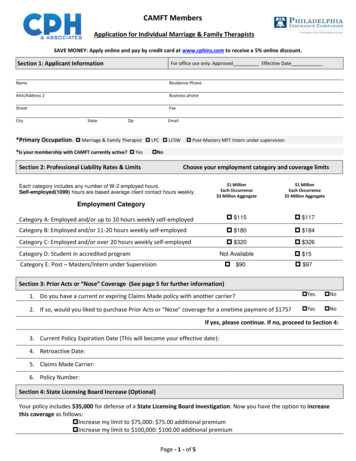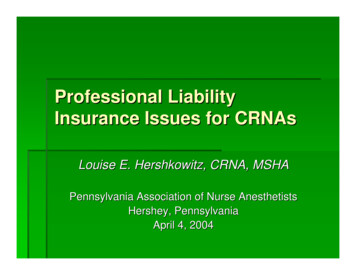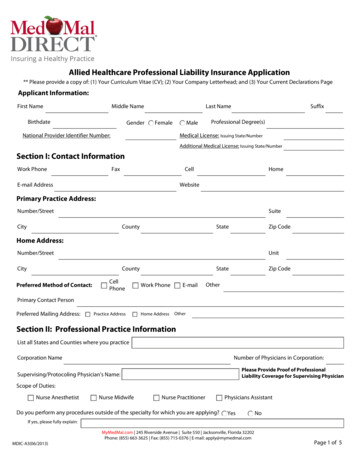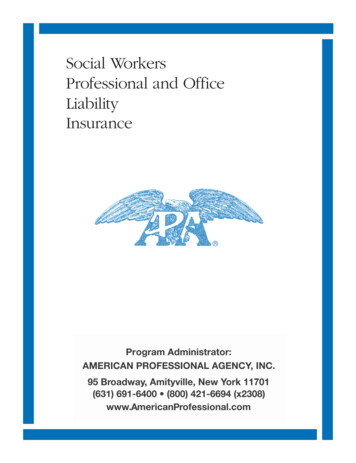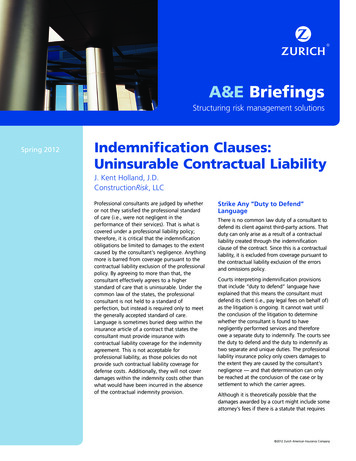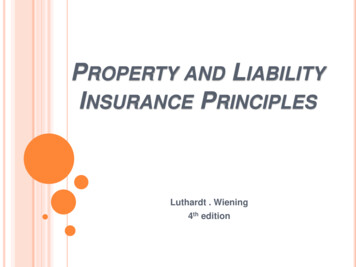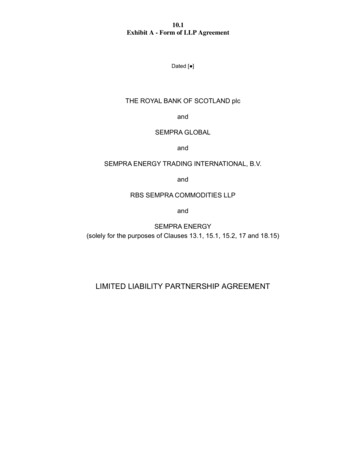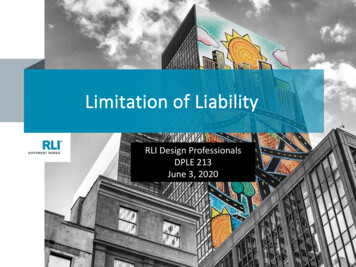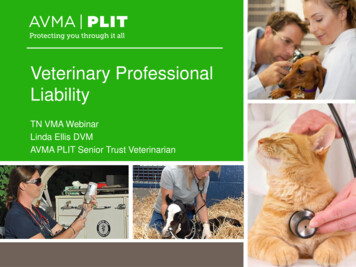
Transcription
Veterinary ProfessionalLiabilityTN VMA WebinarLinda Ellis DVMAVMA PLIT Senior Trust Veterinarian
Agenda Professional liability(malpractice) and veterinarylicense defense- coverages and common claims
Adverse event or unfortunate outcomemay lead to Refusal to pay or request for refund Negative social media postings/cyberbullying Malpractice Claim Board(License) Complaint
What is a Malpractice Claim? Allegation of negligence or practicing below thestandard of care Request/demand for damages(money) Owner may get attorney or file suit May not be negligent but can still be accused
What is a Board Complaint? Complaint filed against a veterinarian with the Statelicensing agency Seeking action against a veterinarian’s license Separate from a malpractice claim
Make sure you are protected! Professional Liability Insurance License Defense Coverage
PLIT Professional Liability Insurance Responds to allegations of negligence or ifmedical/surgical error made Will pay for damages if a mistake ismade/negligence Will defend you if no negligence Purpose is to compensate the client if liabilityexists/mistake made Not mortality or goodwill insurance
PLIT Professional Liability Insurance Defense attorney fees, if indicated, are coveredin addition to policy limits Your individual premiums and insurability are notaffected if you have a claim Non veterinarian employees are covered undera PLIT insured practice owner
PLIT Veterinary License DefenseCoverage Pays for legal fees to defend your veterinarylicense(based on policy limits) Attorney will review your written response to theLicensing Agency and attend Board hearing withyou if required Endorsement to PL policy
Malpractice and Board Complaints Communication issuesInherent risks leading to adverse eventNegligence(mistakes)Human injury(client injured during course oftreatment)Fee Disputes and Collection AttemptsEconomic loss
Avoiding Malpractice and BoardComplaints 70-80% of claims are related to communication
Miscommunication may involve Treatment plans; options Costs Risks; complications Prognosis Surgery or discharge instructions Phone communication– Human pharmacies
Owner Consent Critical piece of communication Owners and Owners’ attorneys haveincreasingly argued ‘Lack of Consent’
Communication claim 12 year old poodle presented for dental Written consent for ‘anesthesia and dental’ Estimate for labwork, fluids and dental Severe periodontal disease was present and 10teeth were extracted Owner became irate when picked up; bill higherthen expected and stated extractions donewithout consent
NSAID claim 9 year old FS Lab with chronic DJD of right stifle Given two week trial of NSAID Dog better and owner requested refill of NSAID Dog started vomiting w/ blood Went to ER/Referral: elevated liver enzymes andsurgery for perforated duodenal ulcer. Dogrecovered after extensive hospitalization
NSAID claim continued Owner attorney alleged 1. no information givento owner about risk of NSAID so no consent and2. no blood work done prior to giving NSAID Negligence? Insured veterinarian consented to settle andclaim settled for 8,900 which were theveterinary costs at ER and Specialty Hospital
How do you obtain owner consent? Discuss risks vs. benefits Use Client InformationHandouts(NSAIDS) Contact owner if somethingchanges or if somethingdifferent needs to be done Document
Avoiding Malpractice and BoardComplaints Good Communication Good Medicine
Practice Good Medicine Have good procedures/processes in place toensure quality/continuity of care Best practices Team effort Team training Continue your education to stay current
Making recommendations Recommend what the animal needs even ifowner has financial constraints Recommend 24 hour care if indicated Recommend referral if indicated Recommend necropsy if cause of death isunknown Document if owner declines
Adverse events still happen Medical or surgical error– Veterinarian or team member Inherent risks
Inherent risks Adverse outcomes without error(no negligence)– Many perianesthetic deaths– Adverse drug reactions, vaccine reaction– Surgical infections
Pre purchase exam Dr. D did PPE on Thoroughbred. Sold for 135K. 3 weeks later buyer contacted Dr. D for prepurchase radiographs and stated her DVM haddiagnosed carpal chip. Dr. D re-reviewed the PPE films and noted themissed bone chip. Owner demanded 142K for purchase price,medical care, and travel/transport
PPE continued Negligence? Dr. D consented to settle Insurance carrier negotiated settlement of 115Kfor horse and 7K for incurred medical costs,travel and transport
Closed pop off valve 8 year old Maltese presented for dental and massremoval Technician induced, intubated and connected to gas After dental dog was repositioned for mass removal andwas light- gas increased slightly and dog bagged fewtimes. Few minutes later it was noted to be cyanotic. Itwas then noticed the pop off valve was closed. Dog arrested and could not be revived Negligence?
Disclosing a medical error Do what is in the best interest of the animal Contact your malpractice carrier for advice onwhat to say and do Communication with client Be professional, be empathetic, don’t getdefensive Be honest. Can you apologize?
Avoiding Malpractice and BoardComplaints Good Communication Good Medicine Keep People Out ofHarm’s Way
Human injury If client is injured during treatment of their animal, this is aprofessional liability matter Bites from dogs and cats– injuries can be minor or catastrophic (includingamputations of finger, limb) Kicks from horses/injuries from large animals Jury/Judges historically not sympathetic to DVMs involved inhuman injury cases- high dollar settlements 18% increase in human injury claims in 1 year
Owner bitten Client presented 2 year old M Mixed breed dogfor ear infection Owner advised dog was difficult to restrain andlast vet had to sedate to exam ears Tech went into room and asked owner to muzzledog Tech attempted to get ear swab and dog“flipped out”
Owner bitten Owner was bitten in face- breaking nose and twofront teeth Medical and dental care 16,500 Negligence? Claim settled for medical/dental costs
Defending Malpractice andBoard Complaints Good medical records
Medical records Critical for defending a complaint If something is not documented, owner orowner’s attorney may argue it did not happen Proves quality of medical care Provides good patient care/continuity of care
Medical records Complete in timely manner Owners entitled to copies upon request Violations often found with Board Complaintsmake sure to review your State Practice Act formedical record keeping requirements
Medical record problems Illegible Not documenting recommendations and what ownerdeclined No consent forms- review these Lack of records or not enough information no anesthetic drugs, dosages, anestheticmonitoring incomplete PE no surgery report, no suture information
Responding to client complaint Request for refund– Was a mistake made or not?– Good will gesture is a business decision If receive Board complaint, any demand fordamages or a mistake is made, contact PLIT
Action Center Helping Veterinarians TakeControl by Taking Action 24/7 access to information forveterinarians facing a potentialor actual professional liabilityclaim or license defensecomplaint www.avmaplit.com/actioncenter
AVMA Cyberbullying resources Cyberbullying hotline– Staffed 24/7– 30 minutes of free consultation– Additional consultation available Reputation management service avma.org
Veterinary license complaints
License complaint The Board responds to complaints from:– Clients– Other veterinarians– Just about anyone The Board does not ignore complaints and areoften bound by statute to investigate
Protecting your rights Entitled to an attorney and an attorney isrecommended The most critical stage of the process is oftennear the very beginning––––Writing your response to complaintTake it seriouslyBe factualBe objective and professional
Board complaint 11 year old mixed breed presented for lethargyand not eating. PE did not reveal any significantabnormalities. DVM recommended bloodwork,UA, and radiographs. Owner declined. Two dayslater dog worse and took to ER whereradiographs showed abdominal mass. Ownerfiled Board complaint alleging insured failed todiagnose dog and should have palpated mass.
Outcome Board closed the case based on DVM’sresponse and medical records which showedcomplete PE with no abnormal findings onabdominal palpation and documentation ofowner declining diagnostics
Summary Make sure you are covered Good communication Good medicineat least ordinary skills, knowledge and Keep owner out of harm’s way Good record keeping Call PLIT if you have a situationwhich may lead to a claim
Questions?Thank you for your attention!linda.ellis@avmaplit.com
More claim examples
Thermal injury 9 year old MN DSH presented for dental andextractions- heating pad used towards end ofprocedure and during recovery 5 days later returned for skin lesion on left side Treated but progressed and referred forextensive thermal injury Negligence? Settled for 6200
Thermal injuries Electric heating pads- do not use Anything placed in the microwave Use safe warming devices
Boxer restraint 15 month old Boxer presented for foot problem Dog anxious and history of fear aggression Muzzled after tried to bite Second tech came in to help hold- dog urinatedand defecated and expressed glands Dog continued to struggle and went limp Revived and referred but later euthanized
AVMA PLIT Senior Trust Veterinarian Veterinary Professional Liability . Insurance carrier negotiated settlement of 115K for horse and 7K for incurred medical costs, . After dental dog was repositioned for mass removal and was light- gas increased slightly and dog bagged few tim

